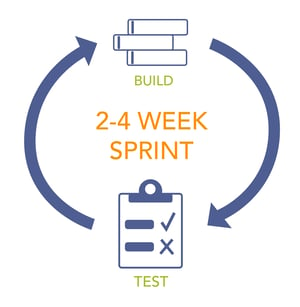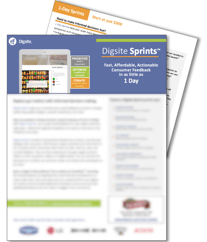Most marketing, innovation and customer experience teams are being tasked with delivering more frequent and faster consumer insights. They are applying agile methodologies to the development of new products, services and marketing touch points. Success requires a mix of new technology to bring agile consumer learning capabilities in-house, as well as specialized outsourced research services to help boost company flexibility and fill in gaps with internal capabilities. But how do you find a research provider that can truly deliver on the promise of agile?
Unfortunately, teams won’t get the results they are hoping for by joining forces with a typical research platform or vendor. You need a partner that is just as committed to achieving your goals as you are. So what does that look like?
Leading agile research providers are excited about the opportunity to help your organization achieve bigger goals and meet accelerated deadlines. They deliver capabilities for highly targeted, customized feedback on ideas under development, from their conception through launch—from cradle to grave. They have a mutual understanding that the speed with which technology and services can inform products, experiences and marketing programs will have a direct impact on your brand’s ability to keep pace with marketplace demands and outperform your competition.
To accomplish these goals, agile providers need to deliver more than shorter timelines and lower costs per idea tests. They should integrate directly into their customers’ internal ecosystems, becoming valuable partners from design to launch while increasing the quality of the decisions each team makes. They also need to scale to address most if not all of the team’s research questions as they arise.
Fundamentally, agile insights providers should be familiar with Agile methods to speed development. Often agile development and optimization is done within two-to-four-week sprint cycles. Each sprint cycle requires researchers to be engaged with cross-functional teams that are simultaneously building solutions and testing those solutions among very specific audiences and in the context of specific purchases or usage situations—and iterating as they learn.
 At the end of each sprint cycle, teams report back to senior management and then determine the scope of the next sprint—evolving from early concepts and arriving at optimized marketing programs, products or customer experiences.
At the end of each sprint cycle, teams report back to senior management and then determine the scope of the next sprint—evolving from early concepts and arriving at optimized marketing programs, products or customer experiences.
When companies partner with the wrong vendor, they can become dissatisfied due to misaligned expectations. For example, while the research these providers deliver may be speedy, the actual scope and quality of their research services may fall short of expectations. Or the research provider may offer all of the research complexity a customer is accustomed to only to slow the process down to a crawl due to their less than agile methods, processes or communication.
Since we launched Digsite Sprints in 2016, we’ve learned a lot about what it means to be a good agile research partner. With that in mind, let’s take a look at six key commitments we believe best-in-class agile research providers make upfront. Each of these commitments are rooted in the agile manifesto and are tailored specifically for agile marketing, innovation and customer experience teams.
1. Quality engagement over quantity of responses

In our experience, more data doesn’t necessarily lead to better insights.
Big data typically is missing the attitudinal information you need in order to understand what that data means. And large-scale surveys often use “representative samples” that end up not having enough of the specific target audience you are truly interested in.
Instead of spending huge amounts to survey an endless amount of people, let existing big data or short-format survey results inform agile qualitative research that can flex to the needs of your specific sprint. Look to quantitative methods for validation only at high-risk milestones and allow multiple iterative qualitative tests to provide convergent validity. In other words, if you do four highly-targeted qualitative sprints that build on each other and reinforce your belief on the best potential solutions, you can take a smaller subset into quantitative validation or even in-market testing with more confidence.
When using this qualitative intensive approach, you need the trifecta of fast, very rich responses among a very targeted audience. At Digsite, we built a proprietary approach to recruiting to ensure that we are able to deliver fast, high quality samples among narrow audiences who have exhibited specific behaviors. We use social media-based recruiting and other behavior targeting to help ensure research participants are the exact kind of people our customers are targeting. Participants who don’t already exhibit relevant behaviors are never invited to participate in the research.
For the team to buy into qualitative-centric sprints, you need to demonstrate that your research methods not only find the right people, but also encourage folks to give high quality responses. For example, research studies have shown that online approaches foster more honesty than research conducted over the phone or in person. What’s more, we've found that participants who have the opportunity to give both private 1-on-1 responses and engage in group interaction or co-creation provide deeper, higher quality engagement. Participants build on each other’s responses and ultimately feel valued and listened to.
Leading agile qualitative technology today allows both private and group engagement within the same platform. But it’s imperative that providers take care to minimize bias. Digsite, for example, can be used to ensure participants share their individual answers in private before they’re able to see other people’s responses.
2. Experiments and experiences over attitudes and beliefs

Agile, as noted above, delivers speed through an approach where you design, build, test and learn within a single sprint—instead of trying to understand everything you possibly can about the strategy or solution before you start designing solutions.
At Digsite, we encourage our customers to focus their internal teams on hypothesis generation and solution-building from the very beginning of each initiative. We believe customers succeed when they engage with cross-functional teams to deliver prototypes early and often instead of getting tied up optimizing ideas before engaging consumers. We believe this approach is critical because it emphasizes observation and experimentation with early solutions at the same time you learn about attitudes and beliefs.
Leading agile research providers go beyond examining attitudes or current beliefs, bridging the gap between what people say and what they do. Otherwise, internal teams will discount partner research results because they are inconsistent with other data.
Look for agile providers that can handle early-stage prototypes at a variety of levels—from 2D sketches to interactive prototypes. We believe that agile partners should be able to create experiential research that gives you a real sense of what the consumer would do at the moment they’ve interacted with your solution.
3. Getting to the “whys” over capturing the “what”

We believe that a researcher’s primary role on agile teams is building empathy.
Without being able to really walk in the shoes of your consumers and see what they see and feel what they feel, you can’t make those nuanced decisions that are the difference between a good and a great solution.
This is why the Digsite platform captures a 360-degree view of the attitudes, behaviors and context of your target consumer. Many other agile solutions only focus on measuring interest in your idea—rather than providing multiple touchpoints over one day or more so you can capture behavior and context, and ask follow-up questions privately or in group settings to get deeper insights.
4. Collaborative learning over functional silos

A surefire way to make sure research is acted upon is by sharing ownership with the decision makers.
This means that cross-functional teams should be engaged beyond simply building the prototype. They should be engaged in prioritizing which target audience has the most need for the solution and framing the situational context and behavior they need to capture. Most importantly, the team should be engaged in the process of learning rather than being sent a report days or weeks after the research is complete.
This is why Digsite gives customers access to results as they’re collected through a customizable real-time InstantReporting. This enables researchers to ensure the team in informed early and often, and that questions and concerns are raised and addressed immediately, increasingly the integrity and buy-in of the ultimate research results.
5. Iterative validation over static testing

Agile development intentionally lowers the risk and consequences of any single decision by breaking development into smaller pieces and building validation over time. In turn, agile research needs to be broken into small tests where teams can get learning in hours or days rather than weeks. Ideally teams can iterate within the sprint cycles, which requires a type of research method that allows for multiple consumer touch-points.
We built Digsite to be iterative first - with every study allowing for two or more consumer touch points. And, we allow for both structured and unstructured responses, so our customers can get feedback on the questions they have, and the ones they don't know to ask until they have seen the first set of responses. This functionality enables you to adjust quickly as new information comes in, building on your learning within the same study—allowing each research sprint truly inform decisions rather than raising more questions.
6. Flexible processes over rigid designs

Agile is loved by some and feared by others because, at its core, it simplifies process and bureaucracy that slow us down. For some, structure and process is what makes their jobs comfortable and efficient. For others, structure and process is what’s holding creativity and innovation back.
We think the only way for research partners to help their customers be agile is for the research partners themselves to use agile processes in their own operations. For Digsite, that meant finding the right team, tools and approaches so our customers can be flexible in every stage of their research sprints. Together, we move research forward quickly, but with the ability to adjust on the fly.
I recently read an article that suggested that the reason large research organizations are struggling to grow while smaller ones are succeeding is precisely because it’s easier for companies to work with smaller, flexible agencies that are less structured. Regardless of the size of your agile research partner, you need to understand the level of flexibility and adaptability they offer and whether that can meet your needs.
Beyond implementing agile practices, we built our technology so that it is easy to use, offering the right amount of structure that enables you to gain efficiencies without losing flexibility. For example, Digsite makes it possible for internal teams to deliver research on-demand through instant recruiting, activity templates and automated reporting. We also layer on services as needed to help expand your team’s bandwidth if you’re low on time. And we have a network of Digsite partners that can help seamlessly deliver additional services like concept development, sprint facilitation and quantitative validation.
Start your journey to agile today!
Becoming agile starts with understanding the principles your team is going to live by and getting your team on board with a new way of working.
Once that’s done, you need research partners that help you deliver on the promise of agile. Otherwise, you won’t be able to move as quickly as you’d like—and it’ll be that much harder to leverage insights to make informed decisions.
By finding research partners that align with your agile approach and offer the flexibility needed to iterate effectively, you’ll have a higher chance of achieving your goals.
To learn more about how Digsite can help your organization to the next level, check out our Digsite Sprints Fact Sheet or request a live demo to see how our team and technology can help companies like yours transform their research.





